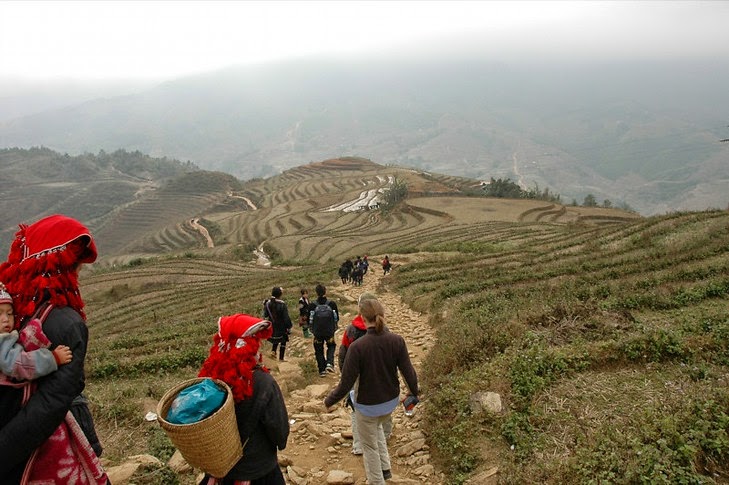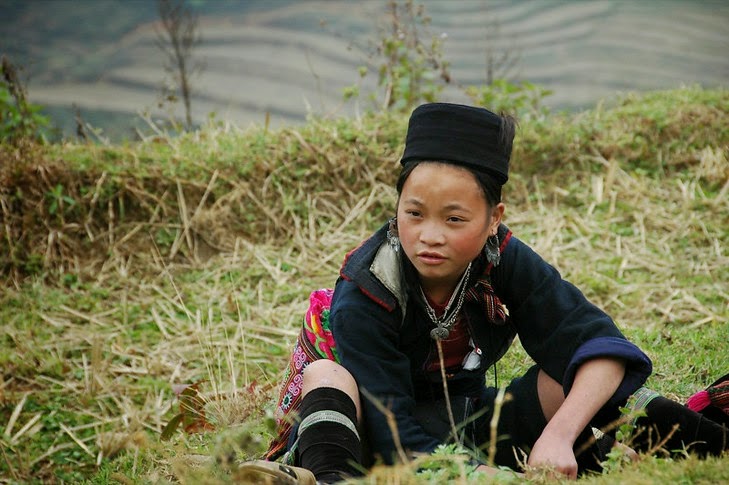By Audrey Scott
Even in winter, Sapa’s landscape dazzles with its rolling hills and terraced rice fields. The villages and people are just as unique. It’s like a portal to another world.
 |
Su was our trusty Black Hmong guide dressed in a dark indigo top and skirt with brightly embroidered trim, velvet strips wrapped around her legs and comfortable sneakers. Within moments of leaving the hotel, we were surrounded by a gaggle of (giggling) girls who came only to hip level and danced around us calling out “what’s your name?” “how old are you?” “do you have any brothers or sisters?”.
Trekking Sapa is like walking through a time warp. Women with bright red headdresses and clothing covered in colorful embroidery walk by with babies and wicker basket backpacks on their backs. Girls are miniature versions or their mothers, learning how to embroider (and sell) at an early age. Boys play in the fields and tend to the water buffalos. Houses are simple structures with dirt floors, often without electricity or running water.
 The second day of trekking tour took us through deeper valleys and muddier paths into villages of other ethnic groups. Children and women with heavy loads on their backs flitted over the hills and steep paths with simple sandals, while tourists in sturdy hiking boots were falling all over each other trying to stay balanced. The simplicity, scope and beauty of the surrounding terraced rice fields was impressive.
The second day of trekking tour took us through deeper valleys and muddier paths into villages of other ethnic groups. Children and women with heavy loads on their backs flitted over the hills and steep paths with simple sandals, while tourists in sturdy hiking boots were falling all over each other trying to stay balanced. The simplicity, scope and beauty of the surrounding terraced rice fields was impressive.
We had a long walk ahead of us and weren’t interested in buying any souvenirs. We were waiting for the shopping opportunities at Bac Ha market. At one of the resting points, a Red Dao woman latched onto me. Acutely aware of her befriend-and-sell strategy, I told her straight away that we weren’t shopping that day. The woman laughed and continued to walk with us.
Sapa is like no other place we’ve visited. It is a visually spectacular, magical place – with its endless hills of terraced rice fields and concentration of hill tribe ethnic minorities whose colorful traditional clothing beautifully accent the landscape. It doesn’t feel like people are wearing traditional attire just to please tourists and their cameras – their dress is a matter of pride and identity.
I wonder how life in the villages and people will change over the next few years. Already, children from the villages stay in town for several days at a time to accompany tourists and sell handicrafts. When I asked Su how tourism had changed her village, she replied that it hasn’t changed it too much yet, but that in 15 years it will be very different. I believe she’s underestimating the pace of change.
Not all change is bad, of course – sometimes it brings a better standard of life with improved health care, education and nutrition. However, if Vietnam wants to preserve the uniqueness and cultures of its ethnic minorities, it will need to responsibly manage the tourism boom in places like Sapa.




0 comments:
Post a Comment